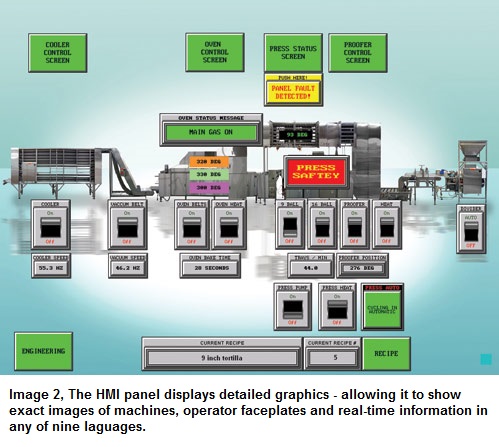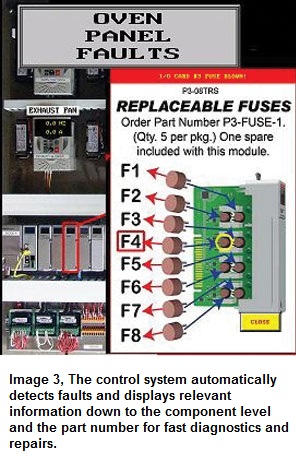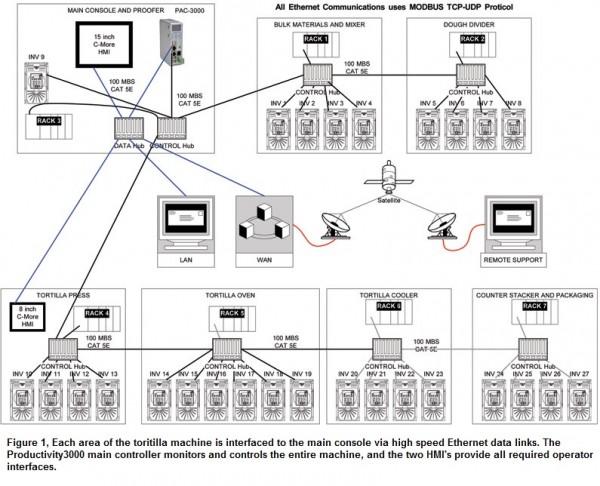Advanced automation helps Casa Herrera produce tortillas reliably, quickly and precisely.
Casa Herrera builds tortilla preparation equipment for the corn and flour tortilla industry, provides equipment for the bakery and snack food industries, and is the preferred supplier to several national brands. We build several varieties of our machines to meet customer specifications, and we install and service all of the equipment we manufacture.
For one of our current design tortilla making machines (see Image 1), we wanted to upgrade the control system. We’ve been building the same machine for seven years, and mechanically it’s proven and reliable. The problem was with the PLC control system. Although the PLC we were using was reputed to be the best in the world, we experienced limitations due to slow speeds and information streaming interference, and the service was adequate at best.
 We wanted to upgrade to a control system that was capable and reliable, and also flexible enough to install on different machines. The control system also had to be easy to maintain, diagnose and repair in the field. After evaluating all of the leading competitors in the field including PLCs, industrial PCs and Programmable Automation Controllers (PACs) – we selected and recently installed a control system from AutomationDirect.
We wanted to upgrade to a control system that was capable and reliable, and also flexible enough to install on different machines. The control system also had to be easy to maintain, diagnose and repair in the field. After evaluating all of the leading competitors in the field including PLCs, industrial PCs and Programmable Automation Controllers (PACs) – we selected and recently installed a control system from AutomationDirect.
For assistance with control system design and implementation, we called in local control systems integrator Memco. Memco works closely with our AutomationDirect value added reseller Quantum Automation (www.quantumautomation.com) on complex control projects such as this one. Memco designed, fabricated, programmed and installed the tortilla control system based on a Productivity3000 PAC, C-more HMI panels, and GS variable speed motor drives – all supplied by AutomationDirect: (www.automationdirect.com).
The Productivity3000 monitors and controls the entire machine via 365 discrete and analog inputs and outputs. Each of the 27 motor drives is interfaced to the controller via a high speed Ethernet data link. The two HMI panels are also connected to the controller via Ethernet. As shown in Figure 1, industrial Ethernet hubs are provided to control and coordinate all data exchange.
Making Tortillas
The first stage of production is dough mixing, where the pneumatic conveyor brings bulk flour to the weigh hopper. The weigh hopper discharges to the mixer, where water and shortening are added and where mixing occurs for a programmed period of time. The mixer then discharges into a dough transportation system that goes to the divider.
The divider extrudes and cuts off precise weight dough balls, and runs them through a rounding table that rolls them into ideal spheres of consistent weight. The dough balls fall into a synchronizing gate on the proofer that drops them into moving tray cups. The pieces rest for 5-10 minutes in the cups, then are discharged in various patterns to the press loader, a series of vertical tubes below the proofer discharge point.
The loader orients the dough balls for correct placement on the press belt in order to optimize pressing head operation. The balls are pre-pressed with pneumatic pistons to shape them into pucks so they won’t slide or roll around when the belt indexes into the pressing section.
The pressing section has a hydraulically actuated upper and lower metal platen plate with three heat zones. The combination of heat, pressure, platen speed and time causes the dough balls to extrude evenly into round tortillas. Surface starches and oils are properly gelatinized and sealed, so the tortillas do not get soggy with wet or juicy fillings.
Tortillas travel next into a maximiser, basically two short conveyors on top of each other that raise and lower pneumatically to receive alternate loads from the press. This machine has four speeds for the top and the bottombelt, two for receiving and two for discharging.
With the proper electronic gear ratios calculated in the controller and communicated to the motor drives, belt speeds can be precisely adjusted. This allows surging product from the press to be fed out in a continuous steady stream to the oven.
The oven is a three-tier design with longitudinal burners, exhaust air management and combustion air control. The control system monitors the belt temperatures using non-contact infrared sensors, and it also controls the burner actuators. The exhaust is controlled based on the input BTU to the system to maximize fuel savings.
Leaving the oven, a vertical vacuum conveyor takes the tortillas nearly straight up, then down the top tier into the atmospheric cooler. The cooler is a series of open weave stainless belts, with cross ventilation, stacked on top of each other. The tortillas flip over when going from one tier to the next for efficient cooling. If lower temperature discharge is needed, the cooler can be installed in a cold room or it can be fitted with an onboard refrigeration unit.
Once cooled, the tortillas go into the counter-stacker which collates them into rows. The rows are typically stacked into groups of 12, 24 or 36 tortillas – although different quantities can be selected as desired. The stacker discharges the stacked tortillas onto a conveyor that leads to an automated bagger that bags, seals, date codes and discharges packages onto a conveyor for final boxing.
Complex Control
With modern automated tortilla machinery, there are many critical timing points throughout the production line. The product is very sticky at the beginning, slippery in the middle, and flexible at the end – making the equipment setup for each area very exacting. The Productivity3000 helps everything stay in sync by controlling all parts of the production line.
Phil McCall, our control system designer at Memco, explains: “In the overhead proofer, each tray is about two inches apart and has a row of nine baskets. Based on the product pattern – two to six pneumatic trippers have to pop out between the trays, tip the tray over to dump the dough balls into the loader and then retract – all in a fraction of a second. This timing is controlled by a main shaft encoder on the proofer, and a proprietary algorithm tips the trays with the proper amount of advance so the trippers always pop out dead center at different tray speeds.”
Another critical timing point is the maximiser between the press and oven infeed. Its purpose is to fill the oven evenly and completely for a good bake, even though the product is coming in uneven slugs from the press.
“We use the extensive math ability of the Productivity3000 – where all variables are in 32-bit floating point – to adjust maximiser top and bottom belt speed, acceleration and deceleration. This allows the machine to accept the rapidly moving slugs from the press and lay them down into an even stream for the oven,” says McCall.
“Using 100 MB/s high speed communications directly to the motor drive, we can adjust the belt speeds in 1-2 milliseconds. We have tried other brands of PLCs and drives and have had unacceptable results, even with products costing two to three times as much,” adds McCall.
The control system components are networked together using Ethernet communications. The network is reliable, very fast, and easy to connect and maintain. The entire database is stored in the Productivity3000 memory, so technicians have full system documentation online.
 The HMIs have extensive graphic capabilities, giving us the ability to display pictures of the machine and of the sub-panels to assist maintenance personnel with troubleshooting (see Image 2).
The HMIs have extensive graphic capabilities, giving us the ability to display pictures of the machine and of the sub-panels to assist maintenance personnel with troubleshooting (see Image 2).
“The Productivity3000 is one of the fastest processors I have ever programmed,” notes McCall. “With the entire line programmed and running, the scan time of the processor and all I/O is 0.6ms. This makes the machine very responsive to the operator. On this application, we used approximately 5% of the system resources. I have no doubt that this system could run multiple lines or even an entire plant, with performance exceeding standalone PLCs, and at lower cost to boot.”
Free Software and Support
The programmable controller, HMIs and motor drives are very straightforward to set up and program. Tag names from the Productivity3000 program were imported into the HMI programming software, which saved lots of time. The analog cards have displays that show the status of each channel and its configuration, so technicians don’t need a meter to perform checks.
The HMIs have the capability for remote viewing, or even full remote control from a standard Web browser. They also have multi-language support – so the names and words on the screen can be changed to one of nine languages at the push of a button – including character or script based languages like Chinese, Japanese and Arabic.
The controller and HMI programming software packages are either very inexpensive or free, with no tech support contracts required. All the technical support we need is also free from AutomationDirect.
Future Perfect
Casa Herrera sells many variants of this line: bigger, smaller, single line and double line. For example, the machine can have one transverse proofer with double drops to two presses, two ovens, two coolers, and two counter-stackers and baggers.
To accommodate these various types of lines, MEMCO devised a scheme where the operating logic in each type of machine on the line is in a separate file. These files are called to action upon the system recognizing various control system components connected to the controller via the Ethernet network.
The Productivity3000 has the ability to ignore a completely disconnected rack or motor drive, and not fault the system. This means that our end users have the entire software program already loaded for any future expansion. All they need to do is power the equipment and plug it into the network.
This also means that we only need to maintain one program for all our tortilla lines sold with the AutomationDirect control system. We are currently working on control system additions to integrate machine vision and robotic handling to the product line. This will allow us to provide our customers with a complete turnkey manufacturing solution.
Troubleshooting Made Easy
When Casa Herrera approached control system integrator MEMCO – we wanted a control system that had a cutting edge intuitive diagnostic system, got around language barriers, and was able to implement remote servicing capabilities over the Internet.
Because virtually all control system information is stored in the controller CPU, the troubleshooting system could be very elaborate. We chose to use high resolution photographs of the panel back plate as-built drawings, showing every component in its relative position. We then used popup windows to overlay the panel drawings in their location on the machine. These pop up windows become visible when any fault occurs, and an animated red box blinks around the problematic item.
The Productivity3000 processor keeps track of the status of system components, and assigns conditions to tag names when we add a module or component. For example, in the tag name database for an 8-channel output card, there is a module fault tag as well as a tag indicating a blown fuse on each of the outputs. We can use this information to bring up a button on the display screen that blinks and informs the operator that there is a module problem.
When the operator presses the button, it takes him to a high-resolution photograph of the machine and of the panel where the blown fuse is located. When the operator touches the picture of the panel, another high-resolution image of the back plate inside the panel appears in front of the enclosure image.
 On the image of the back plate, a red blinking box appears around the suspect module. A high-resolution image of the component side of the output card appears next to the chassis. This image shows the location of the fuse circled in a red blinking box – and the function, type, rating and part number of the replacement fuse in a text window (see Image 3).
On the image of the back plate, a red blinking box appears around the suspect module. A high-resolution image of the component side of the output card appears next to the chassis. This image shows the location of the fuse circled in a red blinking box – and the function, type, rating and part number of the replacement fuse in a text window (see Image 3).
The Productivity3000 system allows hot swapping of modules, so the maintenance person can check the circuit and repair the short. He or she can then pull the card out hot, replace the fuse, reinsert the card and restart the machine. The average time to locate a blown fuse, tripped overload, tripped breaker, power supply problem or drive fault is about two minutes from seeing the fault to having the suspect part identified.
Troubleshooting the motor drives is just as easy. When a drive fault occurs, the same sequence of windows and animation leads the maintenance person to the correct panel. A blinking box indicates the tripped drive, and a text window tells what equipment the drive operates. The box also shows what type of fault has occurred such as overcurrent during running, ground fault at the motor, phase loss or some other abnormal condition.
One of the most unique features of the control system is the transfer of motor drive information. If a customer has a faulty motor drive – the repair procedure is to turn off the power, unplug the communication cable, install the new drive, plug in the communication cable and power up the drive.
Because all motor drive parameters are stored in the Productivity3000’s CPU, upon first scan the processor recognizes the new drive. It then reconfigures the communication port for remote control and downloads all drive parameter settings, all in about 3 seconds. This means that local plant personnel don’t have to be familiar with motor drive or control systems programming to replace a drive.
The troubleshooting system usually enables quick repair to be performed by a mid-level maintenance person. But if the problem cannot be solved quickly on site, the programmable controller and the HMI feature full remote access. With this feature – every I/O module, motor drive and sub-component connected to any of the communication ports can be accessed through the Ethernet data port – either locally, or remotely through a standard Internet connection.
We can remotely view every motor drive parameter as well as every status register. The same goes for every rack, power supply and I/O module. The HMI screens also allow live real-time remote viewing and control so the screen faults can be seen from anywhere. For detailed off-line analysis – the data logs, fault logs and event logs stored on the local USB memory stick can be viewed and downloaded using FTP.
Since the commissioning of the first Productivity3000-based tortilla line for True Foods in Melbourne, Australia – we have gone online from California to monitor the control system in real time. We have added customer-specific changes to the program, and we’ve tuned motor drive parameters. We also added new screen buttons and data trending features to the HMI, all in a matter of minutes.
 By Ron Meade
By Ron Meade
Chief Executive Officer
Casa Herrera
Originally Posted: Sept 1, 2010


